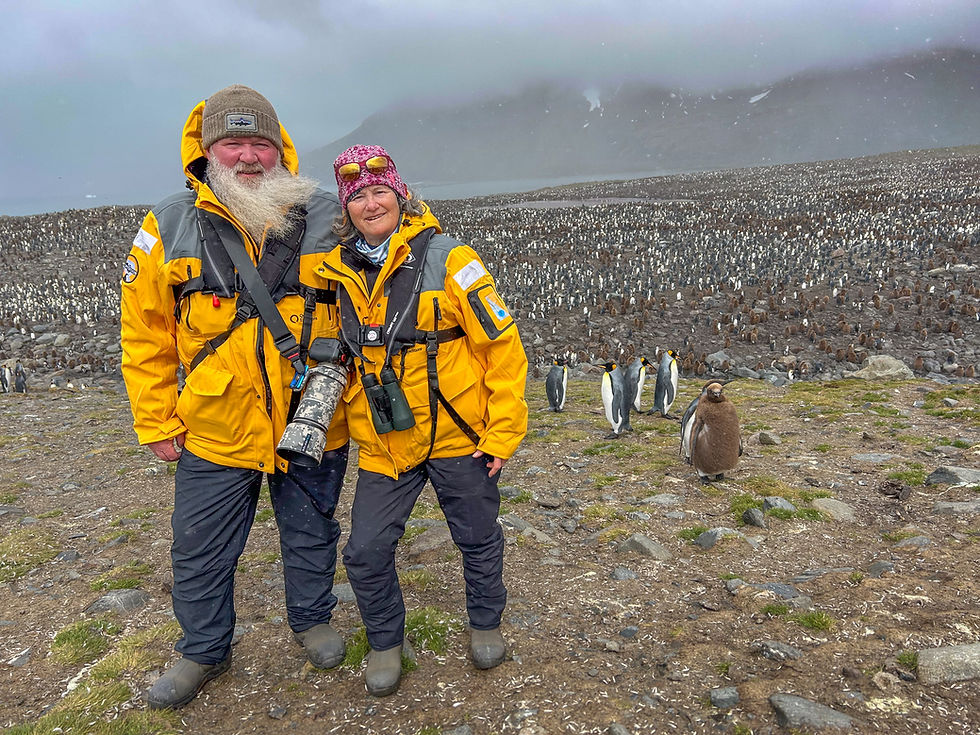Expedition South to Antarctica: Ice, Wildlife, and the Antarctic Circle
- Stu Sharpe
- Jan 13
- 3 min read
Updated: Sep 21
On the evening of December 26, the Ultramarine pulled away from South Georgia Island and turned south into the Scotia Sea once again. Bound for the Antarctic Peninsula, everyone’s spirits were high after such an amazing and unforgettable few days.

27–28 Dec – At Sea
Two days at sea gave us time to rest, take in some presentations, and spend a bit of time on the outer decks bracing the winds and sea spray. On December 27th we passed by Iceberg A23a, which is currently the largest iceberg in the world.
At first, we couldn’t see much at all. Sailing down the calmer, lee side of the iceberg, the poor visibility made the massive ice seem hidden, almost ghostlike. The captain turned the ship around to approach along the windward side, where the visibility was somewhat better. Finally, its size came into perspective — a vast, flat, white expanse stretching to the horizon. It took us over 45 minutes to sail past this massive tabletop iceberg. An astonishing sight, and a reminder of the immense scale of the Antarctic environment.

29 Dec – Point Wild, Elephant Island
On the Afternoon of 29 December we pulled into the waters off Elephant Island and the Captain adeptly backed the ship into a small somewhat sheltered bay. From the stern of the ship we looked toward Point Wild, the narrow beach where 22 of Ernest Shackleton’s men spent four and a half Antarctic winter months awaiting rescue. They survived on penguins and seals and were eventually rescued in August 1916. Unfortunately it was too rough to launch the zodiacs for a landing to explore this historic site, but it was very impactful to see the rolling swells breaking on the narrow beach, surrounded by steep cliffs and the nearby tidewater glacier.


30 Dec – Ice and the Polar Plunge
The following morning we found ourselves in the waters of the Antarctic Peninsula. We embarked on the zodiacs to explore Bone Bay and cruise among the striking blue icebergs. Later in Charcot Bay, we braved the Polar Plunge. We have taken the Polar Plunge before, in Antarctic and arctic waters, but for some reason this one just seemed so much colder.

31 Dec – Hill Bay and Palaver Point
In Hill Bay the weather was perfect for flight operations, so the decision was made to get everyone up for a helicopter flight. The sweeping views of glaciers and mountains were unforgettable. That afternoon we landed at Palaver Point, home to chinstrap penguins and then cruised among the many icebergs. That evening we rang in the New Year as humpback whales surfaced and fed right beside the ship.


1–3 Jan – Penguins and the Antarctic Circle
At Orne Harbour we visited a chinstrap penguin colony with incredible views from the ridge. Crossing the Antarctic Circle the next day was a highlight, celebrated on deck.
The Fish Islands and Chavez Island brought close encounters with Adelie penguins, whales, and leopard seals. This time of year, penguins were still on nests or tending to tiny chicks — very different from our March 2023 visit when chicks were almost ready for the sea.


4 Jan – Yalour Islands, Lemaire Channel, Damoy Point
Adelie penguin colonies filled the Yalour Islands. Sailing the Lemaire Channel was unforgettable — calm seas, sheer cliffs, and drifting ice. We made our final landing at Damoy Point among gentoo penguins.


5–7 Jan – The Drake Passage and Home
The Drake Passage tested us with some lumpy seas and the outer decks closed at times, but soon we were back in Ushuaia. Two more nights in Buenos Aires eased the transition before heading home.

Reflections
This final chapter of the journey gave us unforgettable memories: Shackleton’s story at Elephant Island, crossing the Antarctic Circle, watching whales beside the ship, and seeing so much life thriving in this barren environment. Passing by the world’s largest iceberg was an unexpected highlight, underscoring the immense scale of this wild, beautiful region. A remarkable end to our three-part adventure.

























































Comments